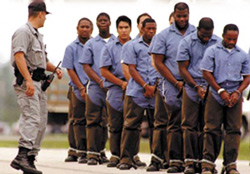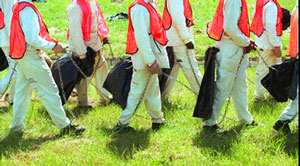America’s New Slavery: Black Men in Prison
By Charlene Muhammad -National Correspondent- | Last updated: Mar 20, 2008 - 4:56:00 PMWhat's your opinion on this article?

Photos: AP/Wide World Photos
Advocates note that the constitution's 13th amendment, ratified in 1865, abolished slavery in the United States, but provided an exception in cases where persons have been 'duly convicted' in the United States and territory it controls, slavery or involuntary servitude can be reimposed as a punishment. |
Advocates note that the constitution’s 13th amendment, ratified in 1865, abolished slavery in the United States, but provided an exception—in cases where persons have been “duly convicted” in the United States and territory it controls, slavery or involuntary servitude can be reimposed as a punishment, they add. The majority of prisoners are Black and Latino, though they are minorities in terms of their numbers in the population.
According to “One in 100: Behind Bars in America 2008,” published by the Pew Center on the States, one in nine Black men between the ages of 20-34 are incarcerated compared to one in 30 other men of the same age. Like the overall adult ratio, one in 100 Black women in their mid-to-late 30s is imprisoned.
“Everyone is feeding off of our down-trodden condition to feed their capitalism, greed and lust for money. They are buying prison stock on the market and this is why they want to silence the restorative voice of Minister Louis Farrakhan, because he is repairing those who fill and would support the prison system as slaves,” said Student Minister Abdullah Muhammad of the Nation of Islam Prison Ministry.
The report states that the rising trend stems from more than a parallel increase in crime or surge in the population at large, but it is driven by policies that put more criminals in prison, extending their stay through measures like California’s Three Strikes Law.

Prisoners from the Limestone Correctional Facility do a trash detail along I-65 in North Alabama near the Tennessee State line while working on a chain gang.
|
Inmates produce items or perform services for almost every major industry. They sew clothes, fight fires and build furniture, but they are paid little or no wages, somewhere between five cents and almost $2.
Phone companies charge high amounts for collect calls and inmate care packages can no longer be sent from families directly. Inmates must purchase products from companies to be sent in, which feeds capitalism, activists charge.
Although the costs of prisons is skyrocketing and consuming state budgets, money continues to be spent to push more Black youth into prison, activists assert. Many education and prison advocates charge there is a plot to populate U.S. prisons based on the dumbing down of America’s youth. Figures show those most likely to be incarcerated and to return generally have the lowest level of education. The report said, “While states don’t necessarily choose between higher education and corrections, a dollar spent in one area is unavailable for another.”
U.S. spending on prisons last year topped $49 billion, compared to $12 billion in 1987. California spent $8.8 billion on prisons last year and 13 states spend more than $1 billion a year on corrections.

The chain gang was re-established in 1995. Becoming one of the first convicts in perhaps a half-century to break rocks, William Crook, 28, of Gadsden, Ala., takes a swing with his 10-pound sledge hammer. Shortly after sunrise, 160 inmates at the Limestone Correction Facility marched a half-mile in leg irons from their dormitories to the rock pile.
|
• Vermont, Michigan, Oregon, Connecticut and Delaware spent as much or more on corrections than on higher education;
• For every dollar spent on higher education, Alaska spent 77 cents on corrections;
• For every dollar spent on higher education, Georgia spent 50 cents on corrections;
• On the average, all 50 states spent 60 cents on corrections for every dollar spent on higher education; and
• For every dollar spent on higher education, Minnesota spent 17 cents on corrections.
Between 1985 and 2005, Texas’ prison population alone jumped by 300 percent.
“All we have to do is follow the logic to see this connection between prisons and enslavement. When you look at prison costs and they say it cost $45,000 to house one prisoner, where does that break down? There’s only three square meals a day. The prisoners make their clothes and bedding in sewing factories and about 90 percent of the items they use in the prisons,” said Nathaniel Ali of the National Association of Brothers and Sisters In and Out of Prison (NABSIO).
He believes the majority of prison costs support guard unions and pay enormous base and overtime salaries of prison guards and other staff.
“They receive these exorbitant wages regardless of their education and training. You don’t have an I.Q.; all you have to have is the ability to be brutal” to command these wages through this new slave system, he said.
Mr. Ali said the public school system has become the feeder to prisons and their slave populations by increasing the heavy presence of school police and sheriffs on middle school campuses and penalties students face for often trivial offenses, other activists added.
Prison watch groups note corporate-owned prisons feed job-starved communities where businesses have disappeared. By incarcerating so many people, America deals with warehousing them and not finding out why they are incarcerated in the first place, advocates said.
“The fact is, it’s a business and a readily accessible, ‘free’ workforce removes prisons’ incentive to rehabilitate, especially those that are owned by corporations,” Atty. Ratliff said.
Laini Coffee, a self-described “unity activist” said, “At current trend, we could very well see the number of so-called free Blacks rival to the same number of those that are incarcerated. The answer is simple: Unity.”
Related news:
The impact of high Black male incarceration rates (FCN, 11-07-2007)
Follow the Prison Money Trail ..to elected officials (In These Times, 09-04-2006)
Profits fuel prison growth (FCN, 03-03-2002)
Black incarceration rates tripled during Clinton Presidency (FCN, 03-06-2001)
The Prison Industrial Complex: Crisis and Control (CorpWatch, 1999)
Private Prisons for Dummies (Paul's Justice Page)
INSIDE STORIES AND REVIEWS
-
-
About Harriett ... and the Negro Hollywood Road Show
By Rabiah Muhammad, Guest Columnist » Full Story -
Skepticism greets Jay-Z, NFL talk of inspiring change
By Bryan 18X Crawford and Richard B. Muhammad The Final Call Newspaper @TheFinalCall » Full Story -
The painful problem of Black girls and suicide
By Charlene Muhammad -National Correspondent- » Full Story -
Exploitation of Innocence - Report: Perceptions, policies hurting Black girls
By Charlene Muhammad -National Correspondent- » Full Story -
Big Ballin: Big ideas fuel a father’s Big Baller Brand and brash business sense
By Bryan Crawford -Contributing Writer- » Full Story






 Click Here Stay Connected!
Click Here Stay Connected!








